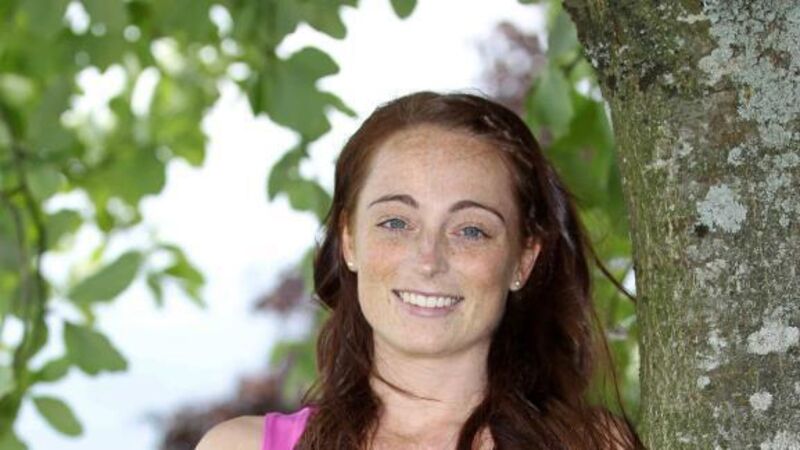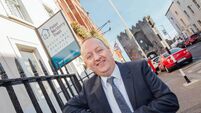Administration adding to the suffering of some in health system

AS A CHILD, Aimee Foley had a couple of brushes with illness that should have raised a few eyebrows.
At age nine, she developed a polyp, a small growth on her bowel. At age 12, she developed a femoral hernia, rare in children her age. Surgery to repair the hernia should have taken 45 minutes. She was on the operating table for two and a half hours. Recovery was unusually slow.
“When I look back now, she was always sick,” her mum, Deirdre, says. “She’d pick up everything that was going. But no one thought there was anything funny going on.”
At age 18 and spreading her wings in Gouves, Crete, Aimee was plagued with kidney infections, coughs and colds. “I was in and out of the medical centre all the time,” she says. “I was constantly on antibiotics. Then I developed a growth beneath my breast.”
On her way to work one morning, the growth began pumping blood. She sat on the footpath; passersby thought she’d been stabbed. She was rushed to hospital. “They did a biopsy. It took four local anaesthetics to numb the skin. It turned out to be non-malignant.” Once again, recovery was painfully slow.
In between the more dramatic setbacks, there were other little niggling illnesses. From age 15, she developed migraines. She suffered from low blood pressure and lots of tummy upsets. She had jaundice.
When she returned from Greece in 2007, she was just a month away from fulfilling her dream of starting cabin crew training with Aer Lingus when illness struck again. She had gone out for something to eat with her boyfriend Steve and came home and started vomiting. She couldn’t breathe. It was then she had her first seizure.
She spent 11 days in hospital undergoing all manner of brain scans. Doctors thought they spotted something but later ruled it out. She was started on treatment for epilepsy. A second seizure followed, then a third. “I lived the life of an epileptic for 18 months,” Aimee says. “I didn’t sit my driving test. I didn’t do my cabin crew training. My doctors felt it was best not to plan too far ahead.”
“Her career in the airlines was over before it ever began,” says Deirdre, “And working for the airlines was her dream.”
Despite her devastation, Aimee chose to get on with her life. She did a two-year course in tourism and travel and passed both years with distinction. She spent two months studying at home, feeling unwell, the side-effects of her epilepsy medication. Migraines got progressively worse. She had pains everywhere. Still, Aimee strove not to let illness dominate her life. “I did my best to have a normal college life although, in the circumstances, I missed out on the social scene,” she says.
In 2009, Aimee was taken off the epilepsy medication after being re-assessed. The neurologist thought the seizures may be cardiac-related. In 2009, she was put on a waiting list for cardio investigations at Cork University Hospital — a list she remains on to this day.
The same year, Aimee ended up in the emergency department at CUH with stomach pains, which she thought were related to coming off the epilepsy medication. Tests were carried out, but inadvertently, the one test that could have led to a correct diagnosis, was not. Aimee was sent home with a diagnosis of gastroenteritis, despite, Deirdre says, barely being able to walk. That night, she became delirious. The pain was intense. After 36 hours, her mother brought her back to the emergency department, this time at the Mercy University Hospital.
A test confirmed acute pancreatitis. Her doctors were flummoxed. She didn’t have gallstones, the single most common cause of acute pancreatitis. She didn’t drink — alcohol is a huge factor. She recovered, thanks, her mother says, to wonderful care, but still no one pulled all the threads of her illnesses together to find the one underlying cause.
Still unwell in 2010 — she had pains in her muscles and joints — but believing the main problem was pancreatitis, she paid a visit to her GP. He thought her profile was substantially out-of-line. He examined Aimee’s back and told her she had a severe curve in her lower spine that could be contributing to rheumatological pain. She went for physiotherapy to try and correct the curve, but it did not relieve the pain. One of the physio’s mentioned that Aimee was hypermobile (an abnormally wide range of movement of the joints). “She said there might be a problem with connective tissue disease,” Aimee says, “but at the time we didn’t realise how significant that was.”
She mentioned the hypermobility to doctors she encountered along the way. No one joined the dots. She ended up back in MUH in 2012 with another attack of acute pancreatitis. She says they carried out a type of MRI scan never done at the hospital before. It involved ordering a special dye from Germany that took four months to arrive. “That’s how willing they were to help Aimee. They felt she deserved to be given that chance,” Deirdre says.
Doctors at MUH were at a lost as to what was causing the pancreatitis. Aimee was referred to Eamonn Quigley at CUH, erstwhile professor of medicine and human physiology at UCC, now retired. “He went through my whole history and while he was examining me, I decided to mention the hypermobility, even though other doctors had ignored it in the past. He said: ‘Hang on, who told you that?’
“I told him it was Cara O’Riordan, my physio in Midleton. He said: ‘I think what we are dealing with is Ehlers Danlos Syndrome.’ Around that time, another consultant of mine, Professor David Kerins at MUH, had mentioned connective tissue disease. These two doctors found the one missing piece of the puzzle. I have the two of them to thank for my diagnosis.”
Aimee, now 26, says her doctors advised her to travel to the UK for a formal diagnosis because of the lack of expertise here in diagnosing such a rare disease. She got a referral to see the appropriate specialist, Rodney Grahame, consultant rheumatologist at the Hospital of St John and St Elizabeth, London. She travelled over in May. He confirmed Aimee had EDS and recommended that she return in June for further assessment in a specialist unit with a view to formulating a treatment plan.
At that point, with money in short supply, Aimee decided to apply for funding from the HSE under its Treatment Abroad Scheme, which allows Irish-based consultants to refer patients abroad for treatments that are not available here. Her initial request was turned down because it was an out-of-date version of the application form, even though she had downloaded it directly from the TAS website. A fresh application was resent a month prior to her departure date for London. Deirdre says TAS were aware of the departure date, as a TAS application cannot be completed without a date from the hospital.
The day prior to departure, Deirdre phoned TAS to enquire about the status of the application and was told the letter was in the post. She explained that they were leaving for London the next morning and asked to know if they’d been approved. Deirdre says she was told the answer could not be given over the phone, only by letter.
Aimee and Deirdre departed for London the following day. While they were away Steve, now Aimee’s financé, picked up her mail. The TAS answer had arrived. It was a refusal. TAS said it did not have the remit to fund applications “for second or specialist opinions”, just treatments.
Aimee argues the treatment she needs is not available here. There is a rehabilitation programme in Harold’s Cross in Dublin but Aimee says it’s not an EDS-specific programme.
PROF GRAHAME outlined some of Aimee’s suffering in a letter he wrote to her GP after seeing her last May.
“Since the age of 21, she developed a superimposed whole-body pain... which causes her to rest during the day time,” he wrote. “She admits to feeling fed up, but is not depressed. She can walk for no more than 20 minutes, sit for one hour, is unable to run and finds stairs difficult... For the past five years she had experienced constipation, bloating, nausea...
“On the basis of the clinical findings, I confirm the diagnosis of Ehlers-Danlos syndrome.”
Prof Grahame felt Aimee was in need of a comprehensive programme of physical rehabilitation adapted to the needs of patients with lax and fragile tissues, coupled with a pain management programme. He said as Aimee did not have health insurance “it will be essential for her treatment to be funded by the state”. Should a rehabilitation programme for specific EDS patients not be available locally another solution, he said, would be to refer her via the NHS to the Rehabilitation Unit at the Royal National Orthopaedic Hospital in Stanmore.
However, Aimee is not prepared to wait for treatment under the NHS, which she says could take nine months. Her quality of life is deteriorating and, in an effort to slow the progress, she follows a rigid exercise regime. Her diet is limited — she has to liquidise some meals. She has Pots disease, characterised by softening and collapse of the vertebrae, often resulting in a hunchback curvature of the spine.
Pots also causes dizziness and abnormal blood pressure on changing positions. She has asthma. She has multi organ complications. She has also begun to experience subluxation, a condition where the joints dislocate, in her case, partial dislocation.
Aimee feels she has lived her life “in the loop of medicine” and can no longer do the things she loves, such as sport, gymnastics, dance. She has set up a Facebook Page (Ireland Wake Up and See the Stripes, a reference to the zebra, the international symbol for EDS) where people can sign a petition in support of her quest for HSE funding. The Hospital of St John and St Elizabeth, London has a hypermobility unit and it’s where she wants to go.
Aimee believes the TAS “makes it difficult for patients to obtain funding, to the extent that families crumble under the pressure of the administrative process”. Ironically, a former classmate also ran into difficulties with TAS.
Gráinne O’Connor, a 27-year-old from East Cork with severe epilepsy, had to go public with her story earlier this year before the HSE agreed to fund essential treatment abroad. Even then, they argued that it was “a once-off funding arrangement” outside the parameters of the TAS.
Aimee is not about to give up, but with an incurable condition that brings complications, some irreversible, time is not on her side.
However the omens are not good. She knows of just one EDS patient in Ireland who has received TAS funding. Despite this, she believes she deserves the best shot she can get.
“As a citizen of Ireland, if the health services lacks adequate facilities to treat an individual, there should be no question but that they receive funding from the state to go where they can be treated. TAS protocols are currently preventing that.”
*Porridge
*Soya milk
*Water
*Prescribed probiotics that cost €41 for 10 sachets and are not covered by a medical card.
*2 x Fresubin 2 kal nutritional drinks (to substitute for an inability to absorb nutrients from food)
*Potatoes
*Cooked carrots
*Quinoa
*Some fruit & vegetables
*Smoothies
*Natural yoghurt
*Small amounts of pasta
*Spelt bread
*Some meals must be liquidised because of difficulties swallowing and digesting food.
*The Avenue Fitness Centre, Midleton, four days a week, where she is on a programme suitable for an EDS sufferer. It consists of core stability and joint stability exercises.
*Cardio workout cannot exceed seven minutes because of POTS (Postural orthostatic tachycardia syndrome) and asthma.
*Corrective pilates six days a week at home.
*Tai chi.
*Ehlers-Danlos syndrome is a genetic connective tissue disorder that affects the joints, skin, and blood vessel walls. Connective tissue is the glue that holds the body together.
People who have EDS usually have overly flexible joints and stretchy, fragile skin. This can become a problem if you have a wound that requires stitches, because the skin often isn’t strong enough to hold them.
There are six types of EDS, and symptoms vary. Overly flexible joints can result in dislocations and early-onset arthritis. Fragile skin may develop prominent scarring. Those with vascular EDS are at risk of often fatal ruptures of major blood vessels. Some organs, such as the uterus and intestines, may also rupture. Pregnancy can increase these risks.
In other forms of EDS, fainting and low blood pressure occurs because blood vessels ‘stretch’.
Stomach wall lining is fragile and bowel ruptures can occur. Constipation and other motility (movement) disorders feature, as does gastroparesis (paralysis of stomach; = inability to process food).
*Aimee’s EDS type: Hypermobility-type EDS.
Excessively loose joints are the hallmark of this EDS type, formerly known as EDS type III. Both large joints, such as the elbows and knees, and small joints, such as toes and fingers, are affected. Partial and total joint dislocations are common, and particularly involve the jaw, knee, and shoulder. Many experience chronic limb and joint pain, although X-rays of these joints appear normal. The skin may also bruise easily. Osteoarthritis is a common occurrence in adults.
*For more: facebook.com/EDSAwarenessIreland and facebook.com/IrelandWakeUpSeeTheStripes












